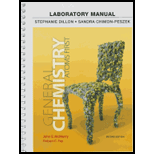Solutions for General Chemistry: Atoms First -Laboratory Manual
Browse All Chapters of This Textbook
Book Details
By Stephanie Dillon with contributions from Sandra Chimon Peszek, DePaul University This laboratory manual contains experiments written specifically to correspond with the Second Edition of General Chemistry: Atoms First by McMurry/Fay. Each experiment covers one or more topics discussed within a chapter of the textbook, with the dual goal of 1) helping students understand the underlying concepts covered in the lecture course, and 2) staying true to an Atoms First Approach. This manual contains thirty-one experiments with a focus on real world applications and a dedication to the Atoms-First Approach. Each experiment contains a set of pre-laboratory questions (also assignable in MasteringChemistry), an introduction, a background section explaining concepts that each student is expected to master for a full understanding of the experimental results, a step-by-step procedure (including safety information), and a report section featuring post-laboratory questions.
Note: This is the standalone book (Laboratory Manual for General Chemistry: Atoms First, Second Edition) if you want the book/access card order the ISBN below: You must have the Instructor ID to access MasteringChemistry. 0321913329 / 9780321913326 General Chemistry: Atoms First Plus MasteringChemistry with eText -- Access Card Package & Laboratory Manual for General Chemistry: Atoms First Package* Package consists of: 032180483X / 9780321804839 General Chemistry: Atoms First Plus MasteringChemistry with eText -- Access Card Package 0321813375 / 9780321813374 LaboraSample Solutions for this Textbook
We offer sample solutions for General Chemistry: Atoms First -Laboratory Manual homework problems. See examples below:
More Editions of This Book
Corresponding editions of this textbook are also available below:
